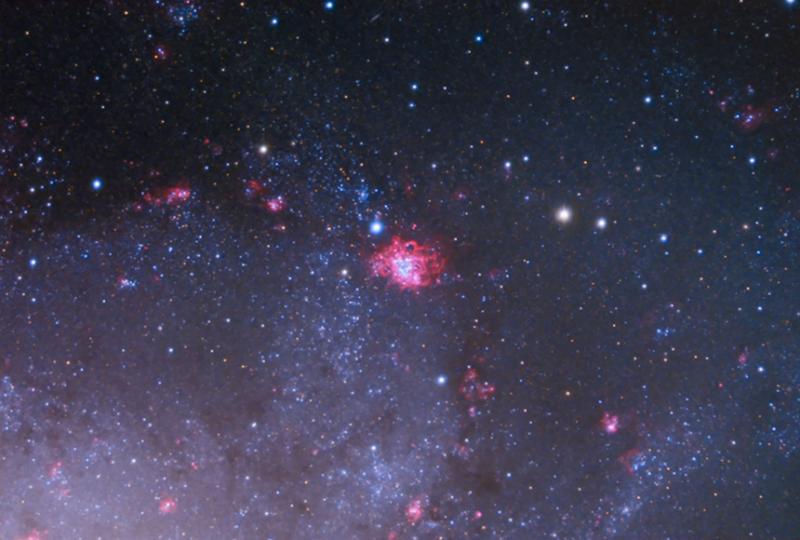Wow, that's just a stunningly lovely picture of M33, the Triangulum Galaxy! The colors are pure eye candy, making M33 look like the loveliest
pinwheel ever! And the resolution is so great that in the full size version, there seems to be a million stars popping out from the background like something you could
sift through your fingers like grains of sand!
APOD Robot wrote:
...this sharp image combines data from telescopes on and around planet Earth...
The data acquisition is top notch, to say the least. And then all this data has been combined into one amazing image by Robert Gendler, who is an extremely skilled "processer".
I wouldn't want to change a thing about this image. Still, it is true that no
one image can tell the full truth about an object as complex as a galaxy. For example, today's APOD is very bright indeed in Hα, hydrogen alpha, which glows pink and red in nebulas all over the disk of M33. The Hα is really there, no question, but how bright is it? Let's compare today's stunning image, which is the product of the collaboration of many telescopes and a man famous for his processing of images, with a picture of M33 that was taken by just one woman, Linda:
Where did all the red Hα go in Linda's image? We don't see much of it in her image because most of the Hα nebulas in M33 are not very bright. Actually, Linda did use an Hα filer for her image, but she made no effort to enhance the Hα in her processing so that it looked even nearly as bright as it does in today's APOD.
But one nebula stands out in Linda's image:
NGC 604. We see it stand out very brightly in Sydney's image, too. It is much less noticeable in the APOD, where it fights for attention with all the other red emission nebulas.
You can see that the overall colors are very muted in Linda's image. Well, that's correct, too. Galaxies get their colors from stars and nebulas, but star colors are muted in themselves. Check them out in a telescope, and you will see.
M33 looks almost "ghostly wan" in Linda's image. The entire galaxy looks bluish to pearly white, and there is the barest hint of yellow in the center of M33 in her image. Well, I'd say that's correct, too. M33 has a rather faint central region, and this galaxy may not even contain a central black hole!

Wikipedia wrote about M33:
The nucleus of this galaxy is an H II region, and it contains an ultraluminous X-ray source with an emission of 1.2 × 1039 erg s−1, which is the most luminous source of X-rays in the Local Group of galaxies. This source is modulated by 20% over a 106-day cycle.
However, the nucleus does not appear to contain a supermassive black hole, as an upper limit of 3,000 solar masses is placed on the mass of a central black hole based upon the velocity of stars in the core region.
Let's return to the color of Linda's image again. Shouldn't the center of M33 look more yellow in her image after all? No, I don't think so. Note that that there is a bright orange star in her image, HD 9687. This star is spectral class K5, similar to
Aldebaran, and its B-V index is ~1.55. That's quite yellow. But the integrated B-V index of M33 is 0.55. That's a very big difference, even though the center itself is certainly a bit yellower than the galaxy as a whole. A likely B-V for the center of M33 might be 0.65, similar to the Sun.
So, no, the small and faint center of M33 that doesn't even contain a supermassive black hole shouldn't be portrayed as very yellow, if we want to imagine its "true" color.
But the color of the center of M33 is orange-yellow in the Hubble image of M33, isn't it? That's true, and I'm unimpressed. I don't think the center of M33 is as orange as it looks in the Hubble picture.
Ann
 M33: The Triangulum Galaxy
M33: The Triangulum Galaxy


